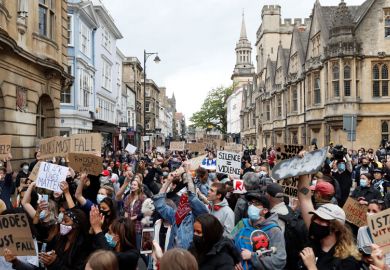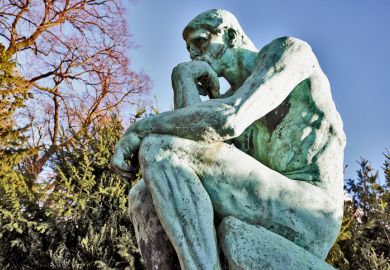Rising East is a new journal from the faculty of social sciences of the University of East London. Professor Michael Rustin is the chair and the editor is Tim Butler from the department of sociology. The department has the good luck to have on its staff a prominent poet in Carole Satyamurti. Sociology is strong at this university; it has not given way to media and cultural studies.
The cover picture on the first issue is of Canary Wharf. Indeed, the area within which the lighted, lofty tower can be seen at night constitutes a new definition of east London. Around there is no longer "darkest London", as it used to be called by Charles Booth and General Booth - itself an old problem of definition that none of the authors from this particular east London university has yet tackled head on. The university is to build a new campus near Canary Wharf on a strip of land by the City Airport. The hope frequently expressed by different contributors is that east London is in the process of its most substantial regeneration for over a century. The west of London has been boom city. The east may follow. If Canary Wharf is the totem pole, facing it across the river will be the Dome.
Tim Butler in his editorial for Vol.1, No.2 gives credit to Michael Heseltine and his adviser, Peter Hall, for giving the initial impetus. It gave rise to the concept of the Thames Gateway running alongside the Thames and taking in the proposed international station at Stratford if (or if only?) the Chunnel link is completed. The Jubilee Line will come before that and help to make this newly named Thames Gateway a centre "for retailing, producer services, business and financial services, manufacturing, logistics and printing". The new campus for the university near Canary Wharf is to house the Thames Gateway Technology Centre.
It is perhaps odd that a gateway is not thought of as a place you pass through to get somewhere else but a place, and a very large place, in its own right with a population (according to one estimate cited by Rustin) of 2.5 million. It is no better when the gateway becomes, as it often does, a corridor.
We are treated to many other minted descriptors. A paper by Martin Simmons and Abigail Warren pepperpots the whole Gateway with the new jargon. In Stratford, for example, an "Industrial Business Park" is to be within the "Strategic Employment Sites framework". "RPG9A (DoE 1995) indicates the Rail Lands as the focus for a wider development area including Hackney Wick, Thornton Fields and Temple Mills. Consequently it forms a key part of strategy for the Objective 2 area in east London and the Lea Valley (GOL 1995)". Where, oh where, is Carole Satyamurti? She cannot be submerged in the 120 designated partnerships in the sub-region, as it is unmellifluously called. Sub what? Most of the authors, without falling victim to the new jargon of the quangocracy, welcome what lies behind it. This applies even to the Dome. In contrast to the snarling of the ordinary press, Liz Greenhalgh manages to make out a good case for it. Something on a large scale has to be done to mark the millennium. "If we regularly celebrate New Year's Eve, then why not celebrate with greater energy the end of the century, the end of the millennium and look forward, if not to the next 1,000 years then the next century, or even just the next decade."
If there is to be a celebration on the theme of time, it would best be in Greenwich - GMT are initials that almost everyone knows. If in Greenwich, it has to be on open ground. The 181-acre derelict site that has been chosen almost chose itself. "The land covers a huge and important river frontage of the Thames, but is currently closed and unused. On the face of it, reclaiming such an area of previously derelict land is uncontentious. Its redevelopment has little negative impact; it does not involve uprooting and re-housing large numbers of people."
Greenhalgh almost makes Greenwich seem like a walkover for Peter Mandelson, if only he can deal with what is ironically the biggest problem left, of time. I hope he can.
Greenhalgh's paper is next to another, by Cathy Ross, on another local exhibition at the inauguration of the East London Museum of Science and Art (now the Museum of Childhood) in 1872. The prince and princess of Wales did the opening, the princess "in a pink bonnet and polonaise of the same colour, trimmed with point lace over a crimson petticoat". The streets of Bethnal Green were lined with people and banners inscribed "Long live Royalty, Science and Art" and "Thank you for your kind visit". The people of the east welcomed the people of the west who had brought in their artefacts with a public street display for the benefit of the visitors of their own household property.
The new projects, however named, do give a buzz to the journal as to many people in east London. Since there is inward investment and it is going to change the place radically, it is very worthwhile having a journal which will keep readers up to date with the economic changes. The accounts already given in the first three issues of the journal reflect the partnership between the university and London East Training and Enterprise.
Another service the journal can provide is to recount the gloomier side of the story. The improvements in infrastructure have hardly touched the indigenous white population. The Asians who have trooped into the university and other institutions of higher education are perhaps more attuned to it. In inner east London only about half of men aged between 16 and 64 are in employment. The inner boroughs are the most deprived, or among the most deprived districts in the UK. By and large, the new wealth has not come to the indigenous people but to people who have travelled in for the jobs and gone home at night to somewhere else to spend their money.
For anyone interested in this great city within a city the journal is a most valuable resource. My only gripe is that despite its subtitle of "east London studies", there is barely a mention of the other universities and research groups in east London, no mention of the work being done at, and no contributions from the Queen Mary and Westfield College, Greenwich University or Guildhall University.
Lord Young founded the Institute of Community Studies in Bethnal Green in 1953.
Rising East: The Journal of East London Studies (three times a year)
Editor - Tim Butler
ISBN - ISSN 1367 787 X
Publisher - Lawrence and Wishart
Price - £100.00 (corporate); £50.00 (institutions); £ 20.00 (individuals)
Pages - -
Register to continue
Why register?
- Registration is free and only takes a moment
- Once registered, you can read 3 articles a month
- Sign up for our newsletter
Subscribe
Or subscribe for unlimited access to:
- Unlimited access to news, views, insights & reviews
- Digital editions
- Digital access to THE’s university and college rankings analysis
Already registered or a current subscriber? Login



